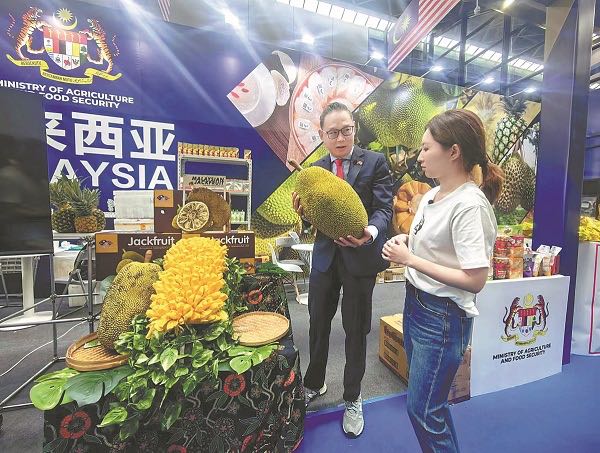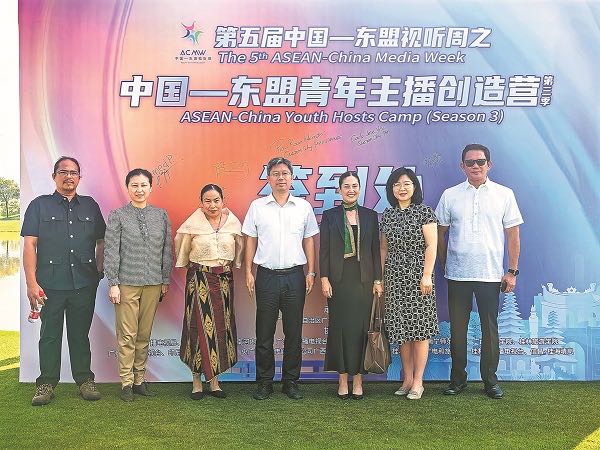Guangxi shining bright as bridge to ASEAN

A Malaysian exhibitor (left) presents a jackfruit to a visitor during the 20th China-ASEAN Expo and China-ASEAN Business and Investment Summit in Nanning, South China's Guangxi Zhuang autonomous region, in September. [PHOTO/CHINA DAILY]
Region has been key conduit for trade, biz with Southeast Asia
With 20 years of development, South China's Guangxi Zhuang autonomous region has become a strategic gateway between China and member countries of the Association of Southeast Asian Nations, boosting trade ties and communication between both parties.
At a flourishing terminal in Qinzhou, Guangxi, a giant bridge crane unloads goods under the control of automated equipment, while container trucks shuttle along a U-shaped wharf, the world's first wharf of such a shape.
A human controller of the dock remotely controls the loading and unloading equipment, using technologies such as artificial intelligence, big data and cloud computing. Through the 5G intelligent cargo system, the dock is becoming more and more efficient and automated.
With more loading and unloading points, it can accommodate more gantry cranes in the yard to improve efficiency. The wharf uses low-speed gantry cranes, which increases operational efficiency by more than 30 percent and reduces personnel by 90 percent.
This is a typical scene of the Qinzhou automated container terminal at Beibu Gulf Port in Guangxi — China's first sea-rail intermodal automated container terminal.
"Automated terminals are more efficient and convenient than traditional ones, with higher container loading and unloading speeds. Within one year of operation, the gross boxes per hour per vessel have surged 152.6 percent, while gross boxes per hour per berth have soared 218.8 percent," said Geng Weining, deputy general manager of the terminal.
"Using electromagnetic navigation, the container truck, which weighs 26 metric tons, has a parking accuracy of within 2 centimeters and a riding accuracy of 5 cm," Geng said.
In the first eight months of this year, cargo throughput at Beibu Gulf Port exceeded 200 million tons, up 11.35 percent year-on-year, the port operator said.
Beibu Gulf Port Group said that more than 5 million twenty-foot equivalent units of containers were handled by the port from January to August, up 14.98 percent year-on-year.
The Qinzhou Port Area in China (Guangxi) Pilot Free Trade Zone, where the terminal is located, is one of three FTZs in Guangxi. In 2019, the State Council issued a notice on the establishment of six new pilot FTZs in China, marking the official launch of the three FTZs in the region.

Officials from China and ASEAN member states attend the opening ceremony of the ASEAN-China Youth Hosts Camp (Season 3), part of the activities of the fifth ASEAN-China Media Week, in Guilin, Guangxi, in May. [PHOTO/CHINA DAILY]
Data from the China-ASEAN Panorama Think Tank showed that by February 2022, there were a total of 17 national opening-up platforms in Guangxi. The region is gradually building a multi-type, multi-level and open platform system with wide coverage.
Twenty years ago, long before the United States realized the important role ASEAN could play in regional affairs, China, as ASEAN's dialogue partner, became the first country to join the Treaty of Amity and Cooperation in Southeast Asia, and together with ASEAN, established a strategic partnership for peace and prosperity.
"Over the years, the combined GDP of China and ASEAN as a share of the global total surged from 6.1 percent in 2002 to 21.5 percent last year, and our 2 billion-plus people are significantly better off. We have upheld win-win cooperation, made breakthroughs in connectivity, and steadily advanced regional economic integration and economic and trade cooperation," said Premier Li Qiang, as he addressed the opening ceremony of the 20th China-ASEAN Expo and China-ASEAN Business and Investment Summit held in Nanning in September.
Trade and investment between the two sides have grown despite a weak global economy. The Ministry of Commerce said China-ASEAN trade grew 16.8 fold over the past 20 years, and they have been each other's largest trade partners for three years running. Two-way cumulative investment has surpassed $380 billion.
Kao Kim Hourn, secretary-general of ASEAN, said: "ASEAN and China's economic performances remain strong despite the challenges and less favorable outlook for the global economy. Both sides have demonstrated remarkable resiliency in recovering from the COVID-19 pandemic. This year, ASEAN's economy is expected to grow 4.6 percent, while China's economy is projected to grow 5 percent."
After the pilot free trade zones in the region were launched, other national-level opening-up platforms are also witnessing Guangxi's efforts in promoting regional cooperation with ASEAN member states. For example, established in 2013, China-Malaysia Qinzhou Industrial Park in Qinzhou now has over 25,000 registered enterprises. The park has formed a cluster mainly consisting of bird nests, palm oil, biopharmaceuticals, electronic information and new energy industry-related products.
Within 11 years of development, the park has achieved a total regional GDP of over 22.94 billion yuan ($3.1 billion), with a compound annual growth rate of 30.7 percent. Total industrial output value has reached 56.39 billion yuan, with a compound annual growth rate of 32.3 percent. The accumulative total amount of two-way trade stands at 27.8 billion yuan, with actual use of foreign direct investment totaling $780 million.
As part of Guangxi's efforts in promoting China-ASEAN communication, the fifth ASEAN-China Media Week will be held from Oct 21 to 27. So far, a series of events have already been held. For example, the ASEAN-China Youth Hosts Camp (Season 3) recruits young hosts from cities related to the Belt and Road Initiative, to tell the story of development and win-win cooperation between China and ASEAN member states.
"By last year, ASEAN-China Media Week had held 20 series of activities, invited 10 ASEAN member states to participate — showcasing over 6,000 hours of programs on more than 360 platforms both domestically and internationally — and with 30 cooperation agreements signed. Its international influence has been increasing, with mounting results achieved," said Lu Zhengning, deputy secretary-general of the organizing committee of the media week.
"China and ASEAN enjoy complementary trade. Under the background of the US 'decoupling' from China, China may achieve regional integration through cooperation with other regional economic cooperation organizations, such as ASEAN. During the process, Guangxi, as an opening-up window, should grasp opportunities to boost trade and exchange ideas," said Wang Peng, a deputy research fellow at the Beijing Academy of Social Sciences.
